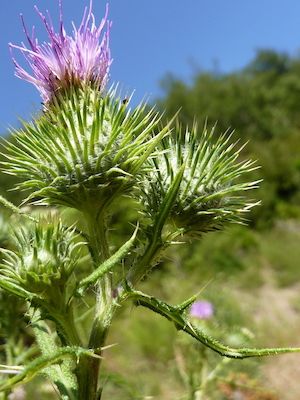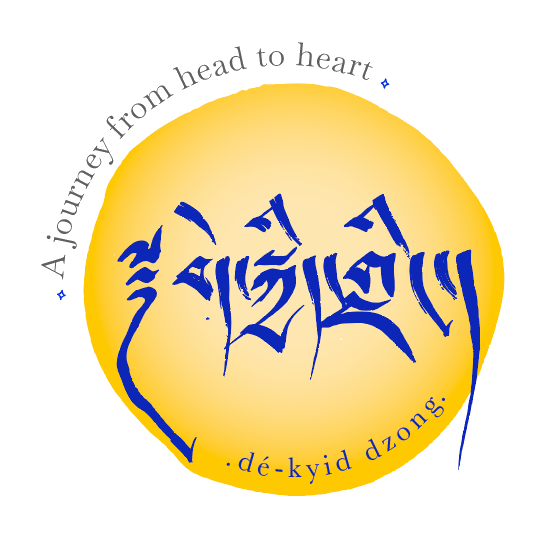BURDOCK
I- Nomenclature

Family: Asteraceae
Common names: Lappa, Fox's Clote, Thorny Burr. Beggar's Buttons, Cockle Buttons, Love Leaves, Philanthropium, Personata, Happy Major, Clot-Bur
Etymology
"coarse, weedy plant," 1590s, from bur + dock, name for various tall, coarse weeds, Old English docce, akin to Middle High German tocke "bundle, tuft".
“Arctium” from the Greek “arktos”: “bear” and “lappa” from the Latin: a bur.
II- Legends and traditions
Ancient Chinese and Indian herbalists used burdock to treat respiratory infections, abscesses and painful joints.
Since the Middle Ages, burdock has been used to treat gout, cancerous tumors, skin problems, sexually transmitted diseases and bladder and kidney problems.
Amerindians used burdock to stimulate uterine contractions for difficult births.
The fresh root is still eaten as a vegetable in China (“ngau pong”), Japan (“gobo”) and Korea ("tong u-eong").
III- Botanical description
Description
Burdock is a biennial that grows from 50cm to 1.5 meters. In the first year it produces a massive rosette of leaves and flowers and seed in the second year. The leaves are generally large, coarse and ovate. They are woolly underneath. The leafstalks are generally hollow.
The root is edible during the first year of growth. It can grow to 6cm in diameter and to a depth of around 1 meter.
The plant flowers from July to October, producing tubular florets with dark purple stamens and whitish styles. The hooked prickles attach themselves easily to the coats of passing animals, which enables the plant to disseminate itself widely.
The plant produces grey achenes (fruit) with a short silky crest.
Habitat
Burdock is native to temperate Europe and Asia. Burdock grows on the edge of paths and woods, as well as on wasteland. It is a nitrophilous plant that likes soils rich in nitrogen.
Harvesting
Harvest burdock roots in the autumn of the first year or spring of the second, prior to flowering. The seeds are ready to harvest when the bur pulls easily off the dry plant. Wear protective clothing and gloves, as the pappus hairs are highly irritating.
Parts used
Roots, leaves and seeds
IV- Active ingredients
Active principles
|
Roots |
Leaves |
Seeds |
|
inuline: 27 to 45% poly acetylenes mineral salts: potassium nitrate bitter phenol acids |
antimicrobial lactones |
essential fatty acids vitamins A, B2 |
V- Therapeutic uses
Properties
|
Roots |
Seeds |
|
antibiotic antifungal antimicrobial purgative diaphoretic diuretic hypoglycemic mild laxative |
antipyretic anti-inflammatory antibacterial reduce blood sugar levels antibiotic |
Uses
For treating skin conditions: abscesses, dermatitis, boils and for cleansing the skin.
Hypoglycemic action for treating diabetes.
Dosage
Root
Decoction: use for skin problems, particularly boils and dry, scaly eczema. 60gr in 1 liter of water. Take 3 cups daily.
Tincture: combine with arthritic and digestive herbs such as yellow dock (Rumex crispus) to detoxify the system and stimulate digestion. Also used in cases of kidney stones.
Lotion: use a decoction for acne and fungal skin infections such as athlete’s foot. Boil 20 gr in a liter of water for 20 minutes. Strain, leave to cool and apply with a compress, or use as a skin lotion.
Leaves
Infusion: for indigestion (one glass before meals) and as a mild appetite stimulant.
Poultice: apply to bruises, skin inflammations and acne. Boil fresh leaves in 1 liter of salty water for 5 minutes. Apply the poultice for 10 minutes.
Infused oil: using the hot infusion method, apply to varicose ulcers.
Seeds
Decoction: Take for colds with a sore throat and cough.
VI- Precaution of use
Counter-indication
Pregnant women
Breast-feeding mothers
Not used internally for children under the age of 15.
Additional information
Burdock leaves are used by some burn care workers for pain management and to speed healing time in natural burn treatment, as it appears to impede bacterial growth on the wound site.
Burdock was the inspiration for the invention of Velcro.


